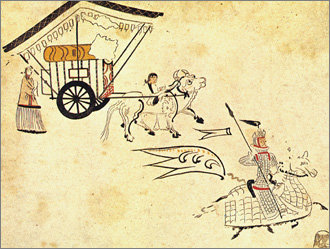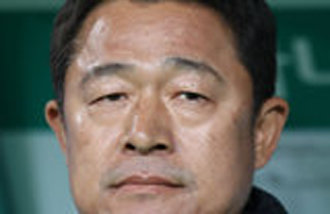War: Why, Why, Why?

The Discovery of Wars To Reconstitute Ancient Korean History
Author: Lee Hee-jin
336 pages, 12,000 won, Published by East Asia
Lee Hee-jin (41), the son of ex-chairman of the National Institute of Korean History, Lee Seong-moo, as well as an expert of ancient war history, reconstructs ancient Korean history of the Three Kingdoms using war as a logical theory of game. This is quite a different and interesting angle from the existing interpretations of the Three Kingdom Era, which mostly have focused on the political history line of the times.
In the movies and soap operas, we often witness soldiers fighting desperately, using all of their military skills. However, those encounters only happen in chaotic fights when both ranks collapsed. In Korean ancient war history, fights between infantrymen betting their lives rarely occurred.
The author tells us that the most important criterion in ancient war is well-organized group trainings, which can produce speed and mobility rather than soldiers martial arts skills. And, the controlling communication during the battle was done through drums and trumpets rather than the outcries of Attack! by the commander- in- chief.
The book is more all-encompassing than old war classics such as Sun Tzus Art of War and Clausewitzs On the Theory of War. It refers to modern wars like the Vietnam War and the Grenada attack, and cites the Starcraft video game as if it were the Bible. For instance, while explaining the importance of topographical conditions in war in reference to the peninsula having plenty of mountains, the book states, Although the narrow gate has small amounts of zealots, you should not charge with a couple of juggling units. It only will bring you devastating results.
Also, due to the topographical conditions of many mountainous areas in Korea, archers units for long distance assaults are more important than the cavalry organized for short distance assaults, although the archers lag behind in mobility, according to this book.
It signifies that the founders of ancient nations such as Joomong and Lee Seong-kye were admired for their great archery skills. In the war history of the Korean Peninsula, there was a huge tendency for generals with good archery skills to have strong performances in wars. It appears not accidental that Korea has great archer athletes, who are dominant in world championship contests, including the Olympics.
With strong background knowledge of ancient wars, the author provides military-perspective explanations as to why Shilla (one of the Three Kingdoms, located in the eastern part of South Korea) did not counterattack Wae (old name for Japan), having been attacked for a couple hundreds years, and why King Gwanggaeto the Great (of Goguryeo, one of the three kingdoms taking up the present North Korea and part of China) helped Shilla in defeating Wae by mobilizing 50,000 soldiers of the army.
The reason Shilla didnt counterattack Japan was because Japan was not developing any ancient nations back then, so there were no substantial nations to conquer. Also, if it had taken over Japan, it might have been difficult for Shilla to maintain its status because of the restraints from the neighboring kingdoms of Goguyreo and Baekje (another kingdom of the era that was located in the western part of South Korea).
The reason King Gwanggaeto the Great mobilized a 50,000-strong army was not to attack Wae, yet it was a great strategy to break the alliance between Baekje, Gaya, and Wae. Wae could attack Shilla using part of the inland of Gaya as a stepping-stone upon joining in the Im-Na Alliance, which was coordinated by King Geunchogo of Baekje, linking Gayas Alliance with Wae. Before the alliance, Wae only could show basic strategies of attacking Shilla though the sea and by then escaping. Bewildered, Shilla asked Goguryo for help, and King Gwanggaeto the Great extracted a great force of army from his northern border and defeated Waes forces using blitz tactics. He also made the Im-Na Alliance powerless in one stroke.
History that is reconstructed through war is never like a round of computer games flickering on a screen. Rather, it is like negative films reflecting the stern and complicated reality of the past, or a documentary reaffirming that history is the record of the winner.
The Gwan-san-seong Battle between Shilla and Baekje, initiated by surprise ambush attacks by Shilla and in which the great leader of flowering Baekje, King Seong, was lost, remains as the critical battle that played a key role in deciding the future of the two nations. However, Baekje attained military superiority over Shilla for 100 years. Furthermore, the collapse of Baekje was explained with the defeat of General Gyebaeks death-defying corps by Shillas forces when the force of Baekje was in internal strife while it fought against the Na-Dang Alliance (between Shilla and the Chinese Tang dynasty). However, Gyebaeks corps was a detached force for blocking the supply route, and the major force of Baekje desperately fought against Tangs force at the Baekma River basin to prevent the force from disembarking its land, according to the book.
Chae-Hyun Kwon confetti@donga.com
Headline News
- Iran blames US sanctions for helicopter crash that killed president
- Pres. Yoon vetoes investigation into death of marine
- “Croatia Holds a Business Forum in Seoul…Looking forward to the development of trade relations”
- Samsung names new chief for semiconductor business
- Seoul City plans to expand welfare benefits







